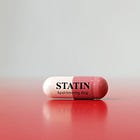Welcome once again!
Now that we’ve taken a deep dive into cholesterol—what it is, what impacts it, what options you have, what to look out for with statins, and how to make informed choices—let’s step back and look at the bigger picture. My goal with this series wasn’t just to help you understand cholesterol but to demonstrate a logical approach to any health issue.
Over the last three posts, cholesterol served as a model for navigating complex health topics. So, whether you’re dealing with high cholesterol, inflammation, blood sugar concerns, or something else entirely, the same principles apply. (If you missed the earlier parts, feel free to catch up below.)
Even if you don’t have high cholesterol, think of any health condition that feels challenging or unclear. These steps can guide you through that, too. Sometimes health management feels so overwhelming that doing nothing seems easier—but with a thoughtful, logical approach, we can start to make sense of our options. Read on to find out how.
Looking at Your Health Holistically
It’s important not to look at any one issue, like cholesterol, in isolation. Often, a health condition isn’t just one isolated problem; it’s part of a broader picture. For instance, if you have high cholesterol, you might also have high inflammation, a common underlying factor in many health conditions. In an upcoming post, I’ll discuss ways to identify if inflammation might be a challenge for you.
But for now, I’d encourage you to consider how this one condition fits into your entire health picture. Functional doctors often recommend more comprehensive health assessments, like an expanded blood panel, to understand these connections better. Doctors like Dr. Mark Hyman, for example, emphasize examining your health holistically to make informed decisions about interventions like statins. See his video about cholesterol here.
Example: Deciding on statins for cholesterol
When it comes to choosing a treatment, such as statins for cholesterol, on simple but extremely useful tool is to simply weigh the benefits and risks. Using cholesterol and deciding whether or not to take statins, a benefit/risk analysis could look like this:
Benefits of Statins:
Lowers LDL cholesterol, slightly raises HDL cholesterol
Reduces the risk of plaque buildup in arteries
Lowers risk of cardiovascular events
Has some anti-inflammatory effects
Simple regimen: just one pill a day
Generally affordable, with many options covered by insurance
Risks of Statins:
Common side effects like muscle pain, fatigue, and digestive issues
Rare, but possible, effects on liver or kidneys
Potential increased diabetes risk for some
Lifelong use is often recommended, which may be a commitment some are hesitant to make
Doing a simple analysis like this can help you see where your priorities lie. Maybe you prefer to rely on a medical intervention that is as simple as taking an inexpensive pill. Or perhaps you would rather be conservative and modify your lifestyle and reduce risk of negatively impacting your other organs. It just depends on your health philosophy, which I write about here. Remember, there is no wrong door. You get to decide what to do, and you bear the results of your decision.
If you’re considering statins (or any other intervention), evaluate your interventions through the framework of the CREECS method. This approach, which I discussed in an earlier post (hint: scroll down toward the bottom), can help you assess Cost, Risk, Effort, Effectiveness, Commitment, and Support for any health decision.
For those of you dealing with cholesterol or any other health challenges and not sure where to start, I’ve got you covered. I’m thrilled to introduce a brand new resource—the Health Guide. (Original name it has not, so we may change it later.) This is a straightforward, practical guide to help you take the next step in managing your health, whatever your goals may be. You’ve learned it all here already, but I’ve compiled it into one short, comprehensive resource.
The Health Guide is designed to help you explore and decide on interventions that align with your unique needs, from lifestyle changes to supplements, medications, or even a blended approach. I’m excited to share this guide as a first step towards a health path that feels right for you—because, ultimately, no one knows your body better than you do.
Download the free step-by-step Health Guide right here!
I’d love your feedback. As always, my DM’s and comments section are open for discussion! Have a great rest of your week and weekend.
In good health,
Dr. Alice
A little more about Dr. Alice Burron and The Health Navigator Group:
You can find more about The Health Navigator Group at our website: www.thehealthnavigator.org
On Instagram: @the.health.navigator
And learn more about Dr. Alice Burron at her website: draliceburron.com
Or via her personal Instagram: @dr_burron
You can even connect with her on LinkedIn, if you want to be professional about it. 👓
And if you’re not subscribed to our Substack, what are ya doing? It’s free, and packed full of useful tools to help you on your journey to better, faster healing.












